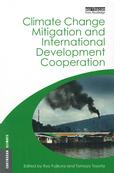Climate Change Mitigation and International Development Cooperation

This book was published this April as a sequel to last November’s Climate Change Adaptation and International Development.
JICA-RI Visiting Fellow Ryo Fujikura (Hosei University) supervised the editing as in the previous book and then JICA-RI Research Associate Tomoyo Toyota was involved in writing and editing as well.
The book introduces the current situation for the international framework for climate change mitigation measures and case studies in Asia. It aims at practitioners working on the policies for climate change, presenting the knowledge and experience of the researchers in Japan and the other part of Asia on climate change mitigation.
The reason why this book took up Asia is twofold: Japan has collected a great deal of knowledge on climate change measures in Asia, and at the same time, this region is becoming the largest producer of greenhouse gases worldwide due to the increasing energy usage with the economic development.
This book has two parts: Part one reviews and analyzes the international framework for climate change, such as UNFCCC (the United Nations Framework Convention on Climate Change) and COP (Conference of the Parties), as well as CDM (the Clean Development Mechanism), REDD+ (Reducing Emissions from Deforestation and forest Degradation). It concludes by covering international intercity cooperation. Part Two introduces analyses of the mitigation policies in China and India, and provides examples of Nationally Appropriate Mitigation Actions (NAMAs) in Thailand.
The final chapter includes the comments on climate change mitigation by two members of the Environmental Law Institute, a US-based NGO that specializes in environmental law.
scroll